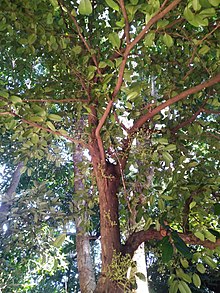Syzygium branderhorstii
Appearance
| Lockerbie Satinash | |
|---|---|

| |
| Cairns Botanic Gardens, August 2022 | |
| Scientific classification | |
| Kingdom: | Plantae |
| Clade: | Tracheophytes |
| Clade: | Angiosperms |
| Clade: | Eudicots |
| Clade: | Rosids |
| Order: | Myrtales |
| Family: | Myrtaceae |
| Genus: | Syzygium |
| Species: | S. branderhorstii
|
| Binomial name | |
| Syzygium branderhorstii | |

| |
| Synonyms[4] | |
| |
Syzygium branderhorstii, commonly known as the Lockerbie satinash, is a small tree in the family Myrtaceae found in New Guinea, the Bismarck Archipelago, Solomon Islands, Santa Cruz Islands, and northern Queensland, Australia.[4] It is cauliflorous, producing large inflorescences from the trunk.[5] The fruits are eaten by brush turkeys (Alectura lathami).[6][7]
Conservation
[edit]This species is listed by the IUCN and Queensland Government's Department of Environment and Science as least concern.[1][2]
Gallery
[edit]References
[edit]- ^ a b "Species profile—Syzygium branderhorstii". Queensland Department of Environment and Science. Queensland Government. 2022. Retrieved 15 November 2022.
- ^ a b Jimbo, T. (2022). "Syzygium branderhorstii". IUCN Red List of Threatened Species. 2022: e.T198692575A202837509. doi:10.2305/IUCN.UK.2022-2.RLTS.T198692575A202837509.en. Retrieved 7 January 2024.
- ^ "Syzygium branderhorstii". Australian Plant Name Index (APNI). Centre for Plant Biodiversity Research, Australian Government. Retrieved 15 November 2022.
- ^ a b c "Syzygium branderhorstii Lauterb". Plants of the World Online. Royal Botanic Gardens, Kew. Retrieved 7 January 2024.
- ^ F.A.Zich; B.P.M.Hyland; T.Whiffen; R.A.Kerrigan (2020). "Syzygium branderhorstii". Australian Tropical Rainforest Plants Edition 8 (RFK8). Centre for Australian National Biodiversity Research (CANBR), Australian Government. Retrieved 15 November 2022.
- ^ Cooper, Wendy; Cooper, William T. (June 2004). Fruits of the Australian Tropical Rainforest. Clifton Hill, Victoria, Australia: Nokomis Editions. p. 360. ISBN 9780958174213.
- ^ Beasley, John (2009). Plants of Cape York - the compact guide. John Beasley. p. 106. ISBN 978-0-9806863-0-2.
External links
[edit] Data related to Syzygium branderhorstii at Wikispecies
Data related to Syzygium branderhorstii at Wikispecies Media related to Syzygium branderhorstii at Wikimedia Commons
Media related to Syzygium branderhorstii at Wikimedia Commons- View a map of historical sightings of this species at the Australasian Virtual Herbarium
- View observations of this species on iNaturalist
- View images of this species on Flickriver
Categories:
- Nature Conservation Act least concern biota
- IUCN Red List least concern species
- Syzygium
- Flora of New Guinea
- Flora of Queensland
- Flora of the Bismarck Archipelago
- Flora of the Santa Cruz Islands
- Flora of the Solomon Islands (archipelago)
- Taxa named by Carl Adolf Georg Lauterbach
- Plants described in 1910
- Trees of Australia







